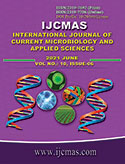


 National Academy of Agricultural Sciences (NAAS)
National Academy of Agricultural Sciences (NAAS)

|
PRINT ISSN : 2319-7692
Online ISSN : 2319-7706 Issues : 12 per year Publisher : Excellent Publishers Email : editorijcmas@gmail.com / submit@ijcmas.com Editor-in-chief: Dr.M.Prakash Index Copernicus ICV 2018: 95.39 NAAS RATING 2020: 5.38 |
Biosafety of six newer and selective miticides / insecticides, dicofol (standard check), abamectin (treated check) along with botanical and biopesticides viz., azadirachtin and Lecanicilium lecani were studied against natural enemies Stethorus spp. on prevailing okra crop during summer, 2015. Two rounds of subsequent foliar applications were given at an interval of two weeks. Observations on surviving natural enemies Stethorus spp. were recorded at 3, 7, 10 and 14 DAT. Mean pre-treatment count of Stethorus spp. was in the range 2.13 - 2.97 Stethorus spp. / leaves. azadirachtin, Lecanicilium lecani, and propargite were found comparatively safer to Stethorus spp. by recording 2.76, 2.57 and 2.46 Stethorus spp. / leaves; bifenazate (1.96), thiamethoxam (1.74), abamectin (1.64) and chlorfenapyr (1.53) were observed the next moderately safer treatments; profenophos + wettablesulphur (1.19) and fenazaquin (0.99) were noticed moderately toxic whereas, dicofol was found harmful by recording 0.57 Stethorus spp. / leaves.
 |
 |
 |
 |
 |